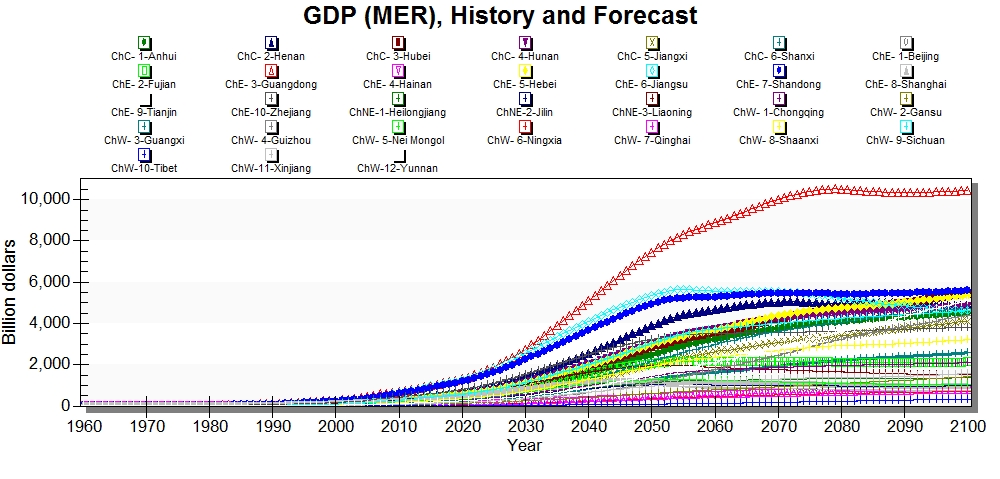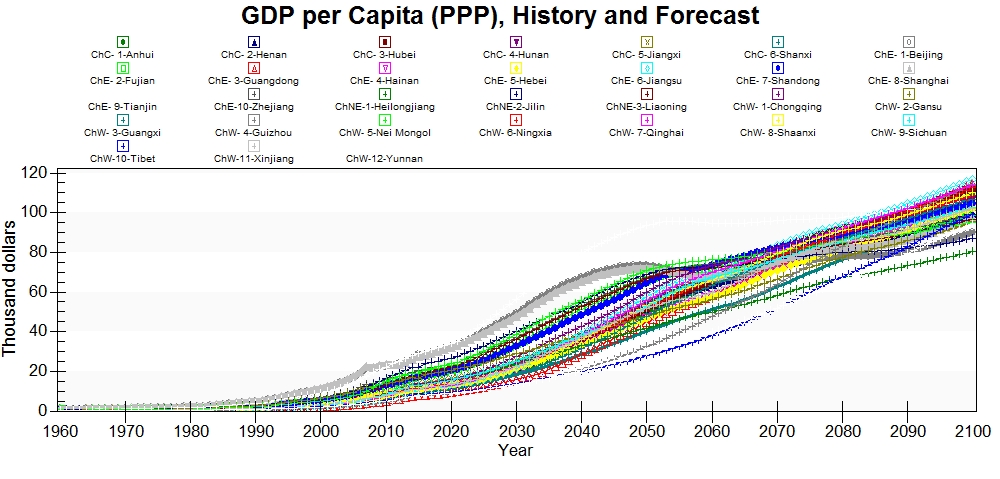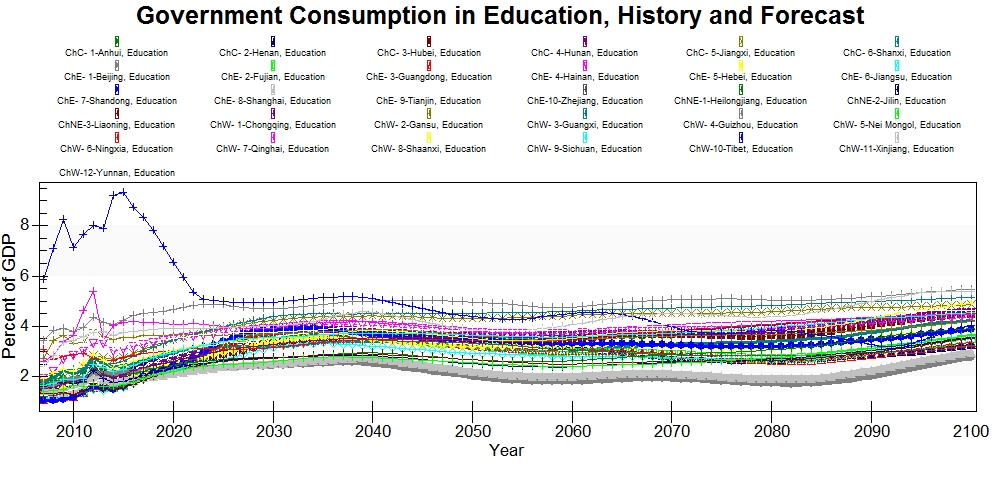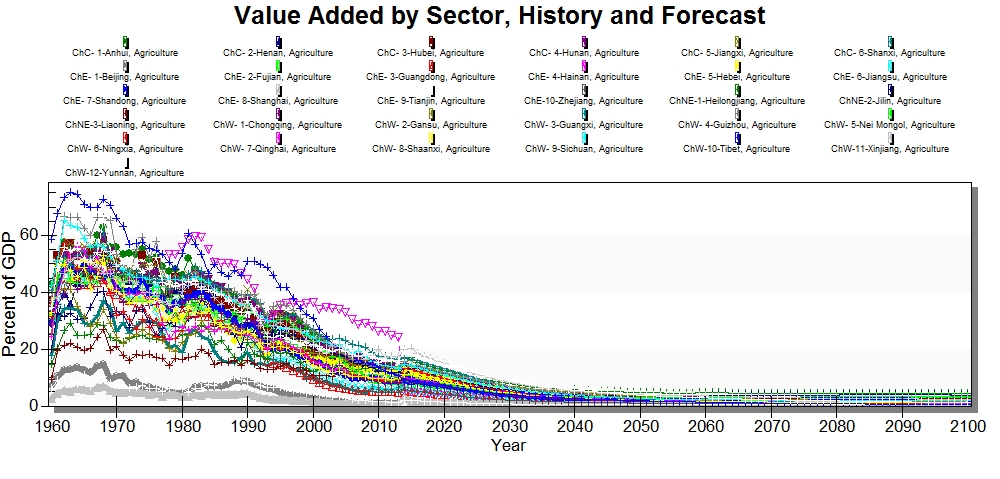Economy Data: Difference between revisions
AltheaDitter (talk | contribs) No edit summary |
AltheaDitter (talk | contribs) No edit summary |
||
| Line 66: | Line 66: | ||
The drop in value added in manufacturing in 2013 is not in the historical data, but does appear in the displayed data. The cause of this dip is unknown, but for the most part the forecasts look like an extrapolation of the rest of the historical data, not the 2013 displayed data. | The drop in value added in manufacturing in 2013 is not in the historical data, but does appear in the displayed data. The cause of this dip is unknown, but for the most part the forecasts look like an extrapolation of the rest of the historical data, not the 2013 displayed data. | ||
= VaddSer% = | |||
Value added in services as a percent of GDP is a blended series in the China SubRegional model with data from the [[China_Statistical_Yearbooks|China Statistical Yearbooks]] and a source that was not recorded by previous researchers. The most recent data 2005-2015 is from the [[China_Statistical_Yearbooks|China Statistical Yearbooks]] 2006-2016 from chapter 3 ''National Accounts'' table 11 ''Gross Regional Product by Three Strata of Industry ''from the column heading ''Tertiary Industry''. | |||
= ExportsMerchandise = | = ExportsMerchandise = | ||
Revision as of 20:57, 17 April 2017
GDP2011
The GDP2011 series came from the China Statistical Yearbooks 2012-2016 from Chapter 3 National Accounts in Table 9 Gross Regional Product and Indices, and this series runs from 2007-2015. The series is in a 2010 base year, not a 2011 base year. Future users may desire rebasing the data to 2011 yuan using a China deflator. Although IFs forecasts GDP in billions of US$, the data used is in hundred million yuan. To convert the data into US$, the box ApplyMultAll is checked in the data dictionary. This function normalizes the provincial data to the full-186 model data.
It is also important to note that in provincial models, the model will not breakout without having additional year columns in the access table. In this case, the historical data begins in 2007, but the year columns in the Access table begin in 1960 and are left blank. This is true for all provincial models in IFs, the GDP series needs year columns back to 1960 even if there is not data available back to 1960. Moreover, if there are any null values in the table, ApplyMultAll must be selected for the model to breakout because the model requires there to be data for all province/years.
There is more historical GDP data available in the China Statistical Yearbooks, but those previous years were chosen to be omitted due to their varying base years. The possibility of taking previous years of data and using China's GDP deflator to change the base year, was considered. Unfortunately, historical data changes in China_Statistical_Yearbooks from year to year making proper estimation difficult. The base year is documented in the notes of each China Statistical Yearbook, but it did not appear to always be correct. An attempt was made to rebase the data to a proper base year and the data did not look right in some years, which suggested that the advertised base year was not always correct. Due to these inconsistencies, the older historical data was not included in the current GDP2011 series.
In earlier iterations of the China provincial model the GDP2011 series ran from 1960-2013, but there were some problems with this data. First the source was not documented, but it appears that the data in part came from the China_Statistical_Yearbooks. The data was not able to be completely verified because data back to 1960 was not found. What was verifiable, showed that multiple base years were blended together for the series. Moreover, the China_Statistical_Yearbooks appear to have had provincial data improperly sorted and reported in some editions 2005 base year data; some provinces look as though their data was swapped. This error looked like a sorting error, where provinces with names that are near each other alphabetically had their data swapped for a few years. Due to these uncertainties, the current GDP series with only 2010 base year data is in use.
GDP2011PCPPP
The data for this series is not in PPP, but rather is normalized into PPP using ApplyMultAll. The series was calculated using the GDP2011 series and population data from the China Statistical Yearbooks from 2012-2016.
GovCon%GDP
Government Consumption as a percent of GDP is a series that was blended using two different data sources that both cited the same original source, the National Bureau of Statistics of China. The data from 2007 through 2015 was calculated using data out of the China_Statistical_Yearbooks 2008-2015. The data is in Chapter 3 National Accounts in Table 17 Final Consumption Expenditure and Its Composition by Region. The column Government Consumption was divided by GDP and then multiplied by 100. The GDP data that was used is the 2010 base year data from the China_Statistical_Yearbooks 2011-2016. There is more historical data available from the China Statistical Yearbooks, but the GDP data prior to 2007 is questionable and is not to be used until the National Bureau of Statistics comments on or remedies this. The data from 1952-2003 came from the China Data Center database from the University of Michigan in table 104 Final Consumption Expenditure Government. The data appears to blend well and the concerns expressed about GDP from some years in the China Statistical Yearbooks does not appear to be an issue in the China Data Center database. The full data series runs from 1952-2003, 2007-2015.
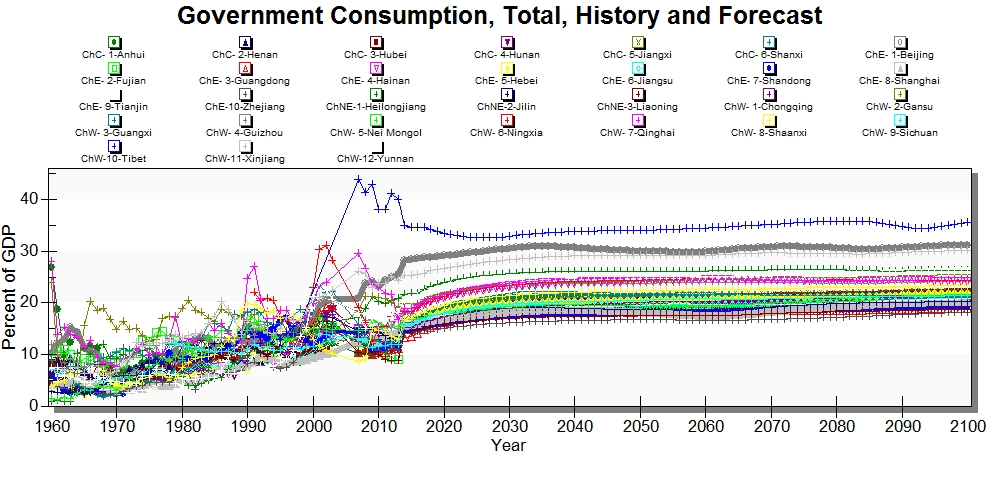 GovtCurRev%GDP
GovtCurRev%GDP
Government current revenues as a percentage of GDP was calculated using data from the China Statistical Yearbooks 2006, 2008-2016. The revenue data is in chapter 7 Government Finance table 5 General Public Budget Revenue by Region. This data was divided by GDP data from the China Statistical Yearbooks for the same years.
GovEdPub%GDP
GovtEdPub%GDP was calculated using data from China_Statistical_Yearbooks 2008-2016. Chapter 7 Government Finance Table 6 General Public Expenditure in the column named Expenditure for Education is where the education expenditure data is located in the 2016 China Statistical Yearbook. The education expenditure data was then divided by GDP from the same source and years. There is more historical data available, but it is not being used because the GDP data for those years is questionable.
GovtHI%GDP
This series was calculated using data that was sourced from the China_Statistical_Yearbooks 2008-2016. The data can be found in Chapter 7 Government Finance Table 6 General Public Expenditure by Region under the column headed as Expenditure for Medical and Health Care, Family Planning. The series is calculated by dividing the health care expenditure data by GDP and then multiplied by 100. There is more historical data available by it is not used because the GDP data from the China_Statistical_Yearbooks published before 2011 is questionable and should not be used.
HouseCon%GDP
Household consumption relative to GDP consists of two series that have been blended together. The original data sources appear to be the same, the National Bureau of Statistics of China and blend together into one consistent series. The most recent data, from 2007-2015, was calculated using data from the China_Statistical_Yearbooks 2008-2016. The data came from Chapter 3 National Accounts Table 17 Final Consumption Expenditure and Its Composition by Region under the column headed Household Consumption. This data was divided by GDP and multiplied by 100 to generate the final series. The older data that runs from 1949-2003 came from the China Data Center database from the University of Michigan and was calculated the same way using GDP data from the China Data Center.
VaddAg%
Value added in agriculture as a percent of GDP is a blended series in the China SubRegional model with data from the China Statistical Yearbooks and a source that was not recorded by previous researchers. The most recent data 2005-2015 is from the China Statistical Yearbooks 2006-2016 from chapter 3 National Accounts table 11 Gross Regional Product by Three Strata of Industry.
Traditionally, the three strata of industry is primary, secondary, and tertiary, where primary industry is made up of all raw material extraction and agriculture. In the China Statistical Yearbooks agriculture is not included in primary industry and is reported separately.
In previous versions of this model the series was from 1960-2013 and the data dictionary citation said that the data came from the China Statistical Yearbook 2006. However, this is obviously incorrect citation because there is more data after the 2006 publication and none of the China Statistical Yearbooks have data from 1960-1980 available online. Thus the origin of the early data is unknown. However, it appears to be correct and blends perfectly with the China Statistical Yearbook data that has been verified.
VaddInd%
This series was found in the China Statistical Yearbooks 1995, 1998-1999, 2002, and 2004-2016 in chapter 3 National Accounts table 11 Gross Regional Product by Strata of Industry and was calculated using GDP from the same years. The definition of industry that is used in IFs is not identical to the definition of industry used in the China Statistical Yearbooks, and thus, despite there being a column headed Industry in the table, this was not used for this series. Rather the sum of the columns Primary Industry and Secondary Industry were summed to estimate the Industrial total in value added. Industry includes activities such as manufacturing and resource extraction, which is essentially primary industry and secondary industry minus agriculture. However, in the China Statistical Yearbooks agriculture is not included in primary industry, and thus, the sum of primary and secondary industry is sufficient to estimate industrial value added.
VaddMan%
This series was found in the China Statistical Yearbooks 1995, 1998-1999, 2002, and 2004-2016 in chapter 3 National Accounts table 11 Gross Regional Product by Strata of Industry and was calculated using GDP from the same years. This series was calculated using the data from the column headed as Industry because in the China Statistical Yearbooks Industry is used to describe manufacturing.
The drop in value added in manufacturing in 2013 is not in the historical data, but does appear in the displayed data. The cause of this dip is unknown, but for the most part the forecasts look like an extrapolation of the rest of the historical data, not the 2013 displayed data.
VaddSer%
Value added in services as a percent of GDP is a blended series in the China SubRegional model with data from the China Statistical Yearbooks and a source that was not recorded by previous researchers. The most recent data 2005-2015 is from the China Statistical Yearbooks 2006-2016 from chapter 3 National Accounts table 11 Gross Regional Product by Three Strata of Industry from the column heading Tertiary Industry.
ExportsMerchandise
This series was pulled from the China Statistical Yearbooks 2013-2016 from chapter 15 Wholesale and Retail Trade table 5 Main Indicators of above Designated Size of Retail Trade by Region. Although there is more data available, only these years were included because the older data is dramatically different from the more recent data.
ImportsMerchandise
This series was found in the China Statistical Yearbooks 2013-2016 from chapter 15 Wholesale and Retail Trade table 5 Main Indicators of above Designated Size of Retail Trade by Region. There is some transients that are included in this data, it was in the original data and for consistency it was included to give four years of data. However, earlier years are even more dramatically different and were not included in the series, despite them being available.
